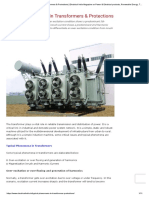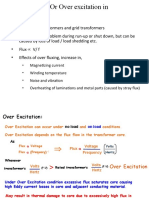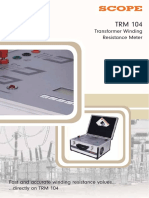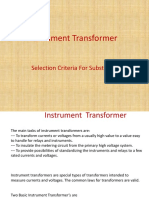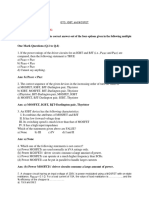100%(1)100% found this document useful (1 vote)
301 viewsOver Current Relay
Over Current Relay
Uploaded by
Abdul HaseebThis document discusses overcurrent relays and relay protection coordination. It provides information on different types of overcurrent relays including instantaneous, definite time, inverse time, and inverse definite minimum time relays. Relay protection coordination aims to minimize the portion of the system affected by a fault by ensuring downstream devices trip before upstream devices. The document outlines the process for calculating actual relay operating times which involves converting fault current, determining the plug setting multiplier from time/PSM curves, and factoring in any time setting multipliers.
Copyright:
© All Rights Reserved
Available Formats
Download as PPTX, PDF, TXT or read online from Scribd
Over Current Relay
Over Current Relay
Uploaded by
Abdul Haseeb100%(1)100% found this document useful (1 vote)
301 views17 pagesThis document discusses overcurrent relays and relay protection coordination. It provides information on different types of overcurrent relays including instantaneous, definite time, inverse time, and inverse definite minimum time relays. Relay protection coordination aims to minimize the portion of the system affected by a fault by ensuring downstream devices trip before upstream devices. The document outlines the process for calculating actual relay operating times which involves converting fault current, determining the plug setting multiplier from time/PSM curves, and factoring in any time setting multipliers.
Original Description:
A Brief Presentation on Over Current Relay & its types.
Copyright
© © All Rights Reserved
Available Formats
PPTX, PDF, TXT or read online from Scribd
Share this document
Did you find this document useful?
Is this content inappropriate?
This document discusses overcurrent relays and relay protection coordination. It provides information on different types of overcurrent relays including instantaneous, definite time, inverse time, and inverse definite minimum time relays. Relay protection coordination aims to minimize the portion of the system affected by a fault by ensuring downstream devices trip before upstream devices. The document outlines the process for calculating actual relay operating times which involves converting fault current, determining the plug setting multiplier from time/PSM curves, and factoring in any time setting multipliers.
Copyright:
© All Rights Reserved
Available Formats
Download as PPTX, PDF, TXT or read online from Scribd
Download as pptx, pdf, or txt
100%(1)100% found this document useful (1 vote)
301 views17 pagesOver Current Relay
Over Current Relay
Uploaded by
Abdul HaseebThis document discusses overcurrent relays and relay protection coordination. It provides information on different types of overcurrent relays including instantaneous, definite time, inverse time, and inverse definite minimum time relays. Relay protection coordination aims to minimize the portion of the system affected by a fault by ensuring downstream devices trip before upstream devices. The document outlines the process for calculating actual relay operating times which involves converting fault current, determining the plug setting multiplier from time/PSM curves, and factoring in any time setting multipliers.
Copyright:
© All Rights Reserved
Available Formats
Download as PPTX, PDF, TXT or read online from Scribd
Download as pptx, pdf, or txt
You are on page 1of 17
GROUP MEMBERS
Abdul Haseeb (2k15-ELE-10)
Muhammad Hassan Khan (2k15-ELE-24)
OVER CURRENT RELAY
&
RELAY PROTECTION
COORDINATION
OVER CURRENT RELAY
Overcurrent Relay is a type of the protection relay, which
operates when the current increases beyond the operating
value of the relay.
Working Principle of Over Current Relay
Types of Over Current Relay
Depending upon time of operation, there are various types
of Over Current relays, such as:-
Instantaneous over current relay.
Definite time over current relay.
Inverse time over current relay.
Instantaneous Over Current Relay
The relay operates as soon as the current in the coil gets
higher than pick upsetting current. There is no intentional
time delay applied. But there is always an inherent time
delay which we cannot avoid practically. In practice, the
operating time of an instantaneous relay is of the order of
a few milliseconds.
Definite Time Over Current Relay
This relay is created by applying intentional time delay
after crossing pick up the value of the current. A definite
time overcurrent relay can be adjusted to issue a trip
output at an exact amount of time after it picks up. Thus,
it has a time setting adjustment and pickup adjustment.
Inverse Time Over Current Relay
Inverse time is a natural character of any induction type
rotating device. Here, the speed of rotation of rotating
part of the device is faster if the input current is more. In
other words, time of operation inversely varies with input
current.
Inverse Definite Minimum Time(IDMT)
over current relay
The characteristic is inverse in the initial part, which
tends to a definite minimum operating time as the current
becomes very high.
Flux saturates at high values of current and the relay
operating torque which is proportional to the square of
flux, and does not increase substantially after the
saturation sets in.
Very Inverse Time Over Current Relay
The inverse characteristic of the relay is more than the
IDMT.
Such type of relay is used in the feeder and on long
transmission lines.
It is used for sensing the fault current which is free from
the fault location.
Extremely Inverse Time Over Current Relay
The characteristic time of the relay is extremely large as
compared to the IDMT and the Very inverse relay. This
relay is used for protecting the cable, transformer etc.
The relay gives the fast operation in the fault conditions
because of their fault time characteristic.
Relay Protection Coordination
Relay Protection Coordination means that downstream
devices (breakers/fuses) should activate before upstream
devices.
This minimizes the portion of the system affected by a
fault or other disturbance. At the substation level, feeder
breakers should trip before the main breaker.
Likewise, downstream panel breakers should trip before
the substation feeder supplying the panel.
Relay Protection Coordination
Relay co-ordination plays an important role in the
protection of power system.
For proper protection, proper coordination of relays with
appropriate relay settings is to be done.
Relay settings are done in such a way that proper
coordination is achieved along various series network.
Relay Protection Coordination
To calculate the actual relay operating time, the following
parameters is needed:
Time / PSM Curve
Plug Setting
Time Setting
Fault Current
Current Transformer Ratio
Relay Protection Coordination
The process for calculating the actual relay operating time is
as the follows:
Convert the fault current into the relay coil current by
using the current transformer ratio.
Express the relay current as a multiple of current setting,
i.e. calculate the PSM
From the Time/PSM curve of the relay, with the calculated
PSM the corresponding time of operation can be obtained.
Determine the actual time of operation by multiplying the
above time of the relay by time-setting multiplier in use.
THANKYOU
You might also like
- Polydoros It / It-S Polydoros It / It-SDocument52 pagesPolydoros It / It-S Polydoros It / It-Smikepower00788% (8)
- Ecu RepairDocument146 pagesEcu RepairJorge Espino100% (19)
- Testing of Distance Protection RelaysDocument8 pagesTesting of Distance Protection RelaysAhmed HamzehNo ratings yet
- P225 TestingDocument2 pagesP225 TestingMuthu Kumar100% (1)
- Diff6T Stabilized Three-Phase Differential Protection For TransformersDocument48 pagesDiff6T Stabilized Three-Phase Differential Protection For Transformersrajesh100% (1)
- Auxiliary Relays RXMB 1 RXMB 2 and RXMC 1Document12 pagesAuxiliary Relays RXMB 1 RXMB 2 and RXMC 1jenskg100% (1)
- Areva MFACDocument30 pagesAreva MFACFerry A ViawanNo ratings yet
- FM Spae01 en BDocument12 pagesFM Spae01 en BSudhakar YsNo ratings yet
- Red 670Document28 pagesRed 670Mahmoud Shafie100% (1)
- Differential Protection of Power Transformer in SubstationDocument4 pagesDifferential Protection of Power Transformer in SubstationEditor IJTSRDNo ratings yet
- What Is Standby Earth Fault RelayDocument2 pagesWhat Is Standby Earth Fault Relaynour100% (1)
- Typical Phenomena in Transformers & Protections: July 5, 2017Document11 pagesTypical Phenomena in Transformers & Protections: July 5, 2017Awnish KumarNo ratings yet
- 025 - Auto Reclose Relay Rev-ADocument4 pages025 - Auto Reclose Relay Rev-AMohammad NasarNo ratings yet
- P94x Micom RelaysDocument398 pagesP94x Micom RelaysLasantha GunatillakeNo ratings yet
- Testing Procedure For Transformer Differential Protection Relay Using Conventional KitDocument14 pagesTesting Procedure For Transformer Differential Protection Relay Using Conventional KitRavi MehroliyaNo ratings yet
- Procedure For TAPCON260: Prepared By: A.Rafeek, Testing EngineerDocument18 pagesProcedure For TAPCON260: Prepared By: A.Rafeek, Testing EngineerMuhammad NasirNo ratings yet
- Ground Distance Relays-Residual Compensation JVDocument33 pagesGround Distance Relays-Residual Compensation JVmatthijsvisser174100% (1)
- 1HID2!2!6005-E600 Relay Setting ProposalDocument15 pages1HID2!2!6005-E600 Relay Setting Proposalbagja wigunaNo ratings yet
- Rel670 - Line DistanceDocument17 pagesRel670 - Line DistanceRatheesh KumarNo ratings yet
- Lock Out RelayDocument4 pagesLock Out RelayFatholla SalehiNo ratings yet
- PSProtection - 7 - OCR Setting Coordination PDFDocument14 pagesPSProtection - 7 - OCR Setting Coordination PDFMuhamadIstikhoriNo ratings yet
- G87 PNL6Document5 pagesG87 PNL6Sukant Kumar MohantyNo ratings yet
- SOTFDocument1 pageSOTFSureshraja99770% (1)
- Magnetizing Current - Winding Temperature - Noise and Vibration - Overheating of Laminations and Metal Parts (Caused by Stray Flux)Document12 pagesMagnetizing Current - Winding Temperature - Noise and Vibration - Overheating of Laminations and Metal Parts (Caused by Stray Flux)Ahmad TukurNo ratings yet
- Current Reversal Logic For Distance Protection: ABB Network Partner ABDocument8 pagesCurrent Reversal Logic For Distance Protection: ABB Network Partner ABRhun Riang ChuahNo ratings yet
- 7SK80 Protection of Medium-Power Motors A1 PDFDocument11 pages7SK80 Protection of Medium-Power Motors A1 PDFpothirajNo ratings yet
- Calculation of Stabilizing Resistor in High Impedance Differential Protection - Electrical ConceptsDocument13 pagesCalculation of Stabilizing Resistor in High Impedance Differential Protection - Electrical ConceptsABHINAV SAURAVNo ratings yet
- Restricted Earth Fault ProtectionDocument15 pagesRestricted Earth Fault ProtectionKuntal SatpathiNo ratings yet
- RCS-978E Transformer Protection Instruction Manual (EN - YJBH1002.0091.1101)Document210 pagesRCS-978E Transformer Protection Instruction Manual (EN - YJBH1002.0091.1101)SrinivasanNo ratings yet
- Protection CheckList Rev01Document4 pagesProtection CheckList Rev01Ramesh EpiliNo ratings yet
- Ground Fault Tripping of Large MotorsDocument5 pagesGround Fault Tripping of Large Motorsclide_050793No ratings yet
- Sel Relay Trip CurveDocument8 pagesSel Relay Trip CurveAnonymous dH3DIEtzNo ratings yet
- Rem 615Document5 pagesRem 615Hari haran100% (1)
- Distance Protection Relay of LineDocument11 pagesDistance Protection Relay of LineYahya DarNo ratings yet
- Ramde RelayDocument8 pagesRamde RelayculwavesNo ratings yet
- N6166 E05 F871 TR Diff Relay 7UT613Document6 pagesN6166 E05 F871 TR Diff Relay 7UT613মোঃ মহসিনNo ratings yet
- 7SA522 - Distance & DEF Relay-ADocument30 pages7SA522 - Distance & DEF Relay-Am khNo ratings yet
- 7UT Relay XFMR PROTECTION RelayDocument9 pages7UT Relay XFMR PROTECTION RelayMoin KhanNo ratings yet
- Scope: Transformer Winding Resistance MeterDocument4 pagesScope: Transformer Winding Resistance MeterL Adly100% (2)
- MJT314 RelayDocument4 pagesMJT314 Relaynkiruthigairaju100% (1)
- Site Test Report: Duba Power Plant (UNITS-7 TO 9) CONTRACT NO: 20721047/00 System: Location: Kks No: DateDocument4 pagesSite Test Report: Duba Power Plant (UNITS-7 TO 9) CONTRACT NO: 20721047/00 System: Location: Kks No: DateAli Khatter100% (1)
- p345 Relay Test ReportDocument23 pagesp345 Relay Test Reportbig bad wolfNo ratings yet
- How To Test Slope of 7SD522 87L Protection - 2Document5 pagesHow To Test Slope of 7SD522 87L Protection - 2BalajiNo ratings yet
- Operating Manual CSDPR-V2-200-NDocument19 pagesOperating Manual CSDPR-V2-200-NJohnTP100% (1)
- Ict-1 Test ReportDocument41 pagesIct-1 Test ReportSuresh Chandra PadhyNo ratings yet
- Test Report CT Supervision Relay MVTP31 End Client: Sec-EoaDocument2 pagesTest Report CT Supervision Relay MVTP31 End Client: Sec-EoaHumayun Ahsan100% (1)
- A Review On Various Transformer Testing SystemsDocument4 pagesA Review On Various Transformer Testing Systemsijsret100% (1)
- Feeder Protection Relay FormatDocument4 pagesFeeder Protection Relay FormatUmapathiNo ratings yet
- Test ReportDocument9 pagesTest Reportganeshapec8100% (1)
- Protection EngineerDocument4 pagesProtection EngineerMuthuRajNo ratings yet
- ISA Introduction To The Test of Protection RelaysDocument23 pagesISA Introduction To The Test of Protection RelaysCata CatalinNo ratings yet
- Current TransformerDocument50 pagesCurrent Transformerilias ahmedNo ratings yet
- Protection CAG 14Document2 pagesProtection CAG 14david wyethNo ratings yet
- Simulation Report of Over Current RelayDocument8 pagesSimulation Report of Over Current RelayAbdul HaseebNo ratings yet
- NED Relay Theory Protection SystemDocument16 pagesNED Relay Theory Protection SystemFaqeeh AbrarNo ratings yet
- Over Current Relay NotesDocument10 pagesOver Current Relay Noteskriitka100% (1)
- Basic Concepts About Relay: Tawsif H. ChowdhuryDocument20 pagesBasic Concepts About Relay: Tawsif H. ChowdhuryNafiul Hossain NabilNo ratings yet
- B) Non-Unit Scheme:: Over Current Relay and Its CharacteristicsDocument6 pagesB) Non-Unit Scheme:: Over Current Relay and Its CharacteristicskarthikNo ratings yet
- New Microsoft PowerPoint PresentationDocument19 pagesNew Microsoft PowerPoint PresentationLoki LokeshNo ratings yet
- Over Current Relay Working Principle TypesDocument4 pagesOver Current Relay Working Principle TypessandystaysNo ratings yet
- 02 - Notes Overcurrent ProtectionDocument9 pages02 - Notes Overcurrent ProtectionM Kumar Marimuthu100% (1)
- Modeling and Simultaneous Management of Electric VehicleDocument16 pagesModeling and Simultaneous Management of Electric VehicleAbdul HaseebNo ratings yet
- Impact of Hybrid Renewable Energy Systems On Short Circuit Levels in Distribution NetworksDocument5 pagesImpact of Hybrid Renewable Energy Systems On Short Circuit Levels in Distribution NetworksAbdul HaseebNo ratings yet
- ETAP Workshop ScheduleDocument1 pageETAP Workshop ScheduleAbdul HaseebNo ratings yet
- ReportDocument16 pagesReportAbdul HaseebNo ratings yet
- Cancer Letters: M.C.F. Simões, J.J.S. Sousa, A.A.C.C. PaisDocument35 pagesCancer Letters: M.C.F. Simões, J.J.S. Sousa, A.A.C.C. PaisAbdul HaseebNo ratings yet
- Seminar: Vishal Madan, John T Lear, Rolf-Markus SzeimiesDocument13 pagesSeminar: Vishal Madan, John T Lear, Rolf-Markus SzeimiesAbdul HaseebNo ratings yet
- Simulation Report of Over Current RelayDocument8 pagesSimulation Report of Over Current RelayAbdul HaseebNo ratings yet
- Short Circuit Analysis Amd Over Current Relaying Protection of IEEE 9 Bus SystemDocument6 pagesShort Circuit Analysis Amd Over Current Relaying Protection of IEEE 9 Bus SystemAbdul HaseebNo ratings yet
- SolarEdge 100A CT Sensor Install GuideDocument3 pagesSolarEdge 100A CT Sensor Install GuideAzeddine AISSAOUINo ratings yet
- 3-Terminal Adjustable Positive Voltage Regulator: General DescriptionDocument14 pages3-Terminal Adjustable Positive Voltage Regulator: General DescriptionAnkitNo ratings yet
- Ficha-Técnica-GROWATT-5000MTL-USDocument2 pagesFicha-Técnica-GROWATT-5000MTL-USemilianominerNo ratings yet
- SontraDocument987 pagesSontraW0549160No ratings yet
- NKCR7.E39050 - Auxiliary Devices Certified For Canada - UL Product IqDocument5 pagesNKCR7.E39050 - Auxiliary Devices Certified For Canada - UL Product IqRamesh JNo ratings yet
- Wire Fuse and SwitchDocument47 pagesWire Fuse and SwitchMacy RiegoNo ratings yet
- BUL49D: High Voltage Fast-Switching NPN Power TransistorDocument6 pagesBUL49D: High Voltage Fast-Switching NPN Power TransistorЯков НижникNo ratings yet
- Transformer Interview Questions AnswersDocument2 pagesTransformer Interview Questions AnswersSourabhPurohit50% (2)
- WSAD2017 T Electrical Guidance NotesDocument6 pagesWSAD2017 T Electrical Guidance NotesEsteban SanchezNo ratings yet
- Nema Ab 1-1986Document45 pagesNema Ab 1-1986Ulysses OreiroNo ratings yet
- CSEBDocument18 pagesCSEBRahul Ranjan100% (1)
- GE LP33 Series 10 4OKVA Technical InstructionsDocument95 pagesGE LP33 Series 10 4OKVA Technical InstructionsMuhammad azeemNo ratings yet
- Silicon NPN Power Transistors: Savantic Semiconductor Product SpecificationDocument4 pagesSilicon NPN Power Transistors: Savantic Semiconductor Product SpecificationDjalma MotaNo ratings yet
- Siemens Eg Type Circuit BreakerDocument15 pagesSiemens Eg Type Circuit BreakerAna Hernández MonterrubioNo ratings yet
- E (209 278) PDFDocument70 pagesE (209 278) PDFMbondiNo ratings yet
- TransformersDocument17 pagesTransformersOmarNo ratings yet
- Reverse Bias Characteristic of PIN DiodeDocument3 pagesReverse Bias Characteristic of PIN Diodesandeep bhukyaNo ratings yet
- Fan RegulatorDocument4 pagesFan RegulatorBinesh KanayiNo ratings yet
- Class11 PDFDocument31 pagesClass11 PDFspyeagleNo ratings yet
- Enya SeriesDocument3 pagesEnya SeriesDavid HerediaNo ratings yet
- Important Questions - APS - IDocument3 pagesImportant Questions - APS - IAakash MehtaNo ratings yet
- Instrum Features: Hazardous Area ConnectorsDocument6 pagesInstrum Features: Hazardous Area ConnectorsNicolae VisanNo ratings yet
- One Mark Questions (Q.1 To Q.6) : Common InstructionsDocument2 pagesOne Mark Questions (Q.1 To Q.6) : Common InstructionsKrishna Charan GudaNo ratings yet
- Ecpassive Components PDFDocument66 pagesEcpassive Components PDFRENJINo ratings yet
- GW150-3.0MW: PMDD Smart Wind TurbineDocument2 pagesGW150-3.0MW: PMDD Smart Wind Turbineark04No ratings yet
- Electronic Voltmeter: Advantage Over Conventional Multi MeterDocument7 pagesElectronic Voltmeter: Advantage Over Conventional Multi MeterVishal Pandey M LE 06No ratings yet
- EEM 355 - Mtronic System - Special Machine Drives 1Document25 pagesEEM 355 - Mtronic System - Special Machine Drives 1Elaine KhooNo ratings yet
- Eaton 277052 DILM17 01 (RDC130) en - GBDocument7 pagesEaton 277052 DILM17 01 (RDC130) en - GBAchafi Moussa MahamatNo ratings yet











